Response of Thin Sheet Metal on the Excitation in Electromagnetic Forming †
Abstract
:1. Introduction
2. Methods
3. Results
4. Discussion
5. Conclusions
Author Contributions
Funding
Institutional Review Board Statement
Informed Consent Statement
Data Availability Statement
Conflicts of Interest
References
- Cui, X.; Zhang, Z.; Yu, H.; Xiao, X.; Cheng, Y. Springback Calibration of a U-Shaped Electromagnetic Impulse Forming Process. Metals 2019, 9, 603. [Google Scholar] [CrossRef] [Green Version]
- Noh, H.-G.; Song, W.-J.; Kang, B.-S.; Kim, J. Two-step electromagnetic forming process using spiral forming coils to deform sheet metal in a middle-block die. Int. J. Adv. Manuf. Technol. 2015, 76, 1691–1703. [Google Scholar] [CrossRef]
- Golovashchenko, S.; Imbert, J.M.; Worswick, M.J. Contributing Factors to the Increased Formability Observed in Electromagnetically Formed Aluminum Alloy Sheet. In Proceedings of the 2nd International Conference on High Speed Forming, Dortmund, Germany, 20–21 March 2006. [Google Scholar] [CrossRef]
- Carson, B.; Daehn, G.; Psyk, V.; Tekkaya, A.E.; Weddeling, C.; Woodward, S. Agile Production of Sheet Metal Aviation Components Using Disposable Electromagnetic Actuators. In Proceedings of the 4th International Conference on High Speed Forming, Columbus, OH, USA, 9–10 March 2010. [Google Scholar] [CrossRef]
- Psyk, V.; Risch, D.; Kinsey, B.L.; Tekkaya, A.E.; Kleiner, M. Electromagnetic forming—A review. J. Mater. Process. Technol. 2011, 211, 787–829. [Google Scholar] [CrossRef]
- Maier-Komor, P.; Hoffmann, H.; Ostermair, M. Cutting of hollow profiles using electromagnetic fields. Int. J. Mater. Form. 2010, 3, 503–506. [Google Scholar] [CrossRef]
- Aizawa, T.; Kashani, M.; Okagawa, K. Application of magnetic pulse welding for aluminum alloys and SPCC steel sheet joints. Weld. J. 2007, 86, 119–124. [Google Scholar]
- Geiger, M.; Kleiner, M.; Eckstein, R.; Tiesler, N.; Engel, U. Microforming. CIRP Ann. 2001, 50, 445–462. [Google Scholar] [CrossRef]
- Thibaudeau, E.; Kinsey, B.L. Analytical design and experimental validation of uniform pressure actuator for electromagnetic forming and welding. J. Mater. Process. Technol. 2015, 215, 251–263. [Google Scholar] [CrossRef]
- Beckschwarte, B.; Langstädtler, L.; Schenck, C.; Herrmann, M.; Kuhfuss, B. Numerical and Experimental Investigation of the Impact of the Electromagnetic Properties of the Die Materials in Electromagnetic Forming of Thin Sheet Metal. J. Manuf. Mater. Process 2021, 5, 18. [Google Scholar] [CrossRef]
- Golowin, S.; Kamal, M.; Shang, J.; Portier, J.; Din, A.; Daehn, G.S.; Bradley, J.R.; Newman, K.E.; Hatkevich, S. Application of a Uniform Pressure Actuator for Electromagnetic Processing of Sheet Metal. J. Mater. Eng. Perform. 2007, 16, 455–460. [Google Scholar] [CrossRef]
- Risch, D.; Vogli, E.; Baumann, I.; Brosius, A.; Beerwald, C.; Tillmann, W.; Kleiner, M. Aspects of Die Design for the Electromagnetic Sheet Metal Forming Process. In Proceedings of the 2nd International Conference on High Speed Forming, Dortmund, Germany, 20–21 March 2006. [Google Scholar] [CrossRef]
- Imbert, J.; L’Eplattenier, P.; Worswick, M. Effects of Force Distribution and Rebound on Electromagnetically Formed Sheet Metal. In Proceedings of the 4th International Conference on High Speed Formin, Columbus, OH, USA, 9–10 March 2010. [Google Scholar] [CrossRef]
- Heidhoff, J.; Beckschwarte, B.; Riemer, O.; Schönemann, L.; Herrmann, M.; Schenck, C.; Kuhfuss, B. Electromagnetic Embossing of Optical Microstructures with High Aspect Ratios in Thin Aluminum Sheets. In Proceedings of the 24th International Conference on Material Forming (ESAFORM 2021), Liège, France, 14–16 April 2021. [Google Scholar] [CrossRef]
- Ma, H.; Huang, L.; Wu, M.; Li, J. Dynamic Ductility and Fragmentation for Aluminum Alloy Using Electromagnetic Ring Expansion. Procedia Eng. 2014, 81, 787–792. [Google Scholar] [CrossRef] [Green Version]
- Langstädtler, L. Elektromagnetisches und Elektrohydraulisches Umformen in der Mikroproduktion. Ph.D. Thesis, University of Bremen, Bremen, Germany, 2020. [Google Scholar] [CrossRef]
- Du, Z.; Yan, Z.; Cui, X.; Chen, B.; Yu, H.; Qiu, D.; Xia, W.; Deng, Z. Springback control and large skin manufacturing by high-speed vibration using electromagnetic forming. J. Mater. Process. Technol. 2022, 299, 117340. [Google Scholar] [CrossRef]
- Xia, W.; Cui, X.; Du, Z.; Deng, Z.; Lin, Y. Springback control with small vibration using electromagnetic forming. Int. J. Adv. Manuf. Technol. 2022, 118, 3133–3145. [Google Scholar] [CrossRef]
- Yang, K.; Taber, G.; Sapanathan, T.; Vivek, A.; Daehn, G.S.; Raoelison, R.N.; Buiron, N.; Rachik, M. Development of Vibration During the Electromagnetic Ring Expansion Test. In Proceedings of the 7th International Conference on High Speed Forming, Dortmund, Germany, 27–28 April 2016. [Google Scholar] [CrossRef]
- Zhai, J.; Guan, Y.; Li, Y.; Liu, Y.; Lin, J. The surface effect of ultrasonic vibration in double cup extrusion test. J. Mater. Process. Technol. 2022, 299, 117344. [Google Scholar] [CrossRef]
- Blaha, F.; Langenecker, B. Dehnung von Zink-Kristallen unter Ultraschalleinwirkung. Naturwissenschaften 1955, 42, 556. [Google Scholar] [CrossRef]
- Hu, J.; Shimizu, T.; Yang, M. Investigation on ultrasonic volume effects: Stress superposition, acoustic softening and dynamic impact. Ultrason. Sonochem. 2018, 48, 240–248. [Google Scholar] [CrossRef] [PubMed]
- Ahmadi, F.; Farzin, M.; Mandegari, M. Effect of grain size on ultrasonic softening of pure aluminum. Ultrasonics 2015, 63, 111–117. [Google Scholar] [CrossRef] [PubMed]

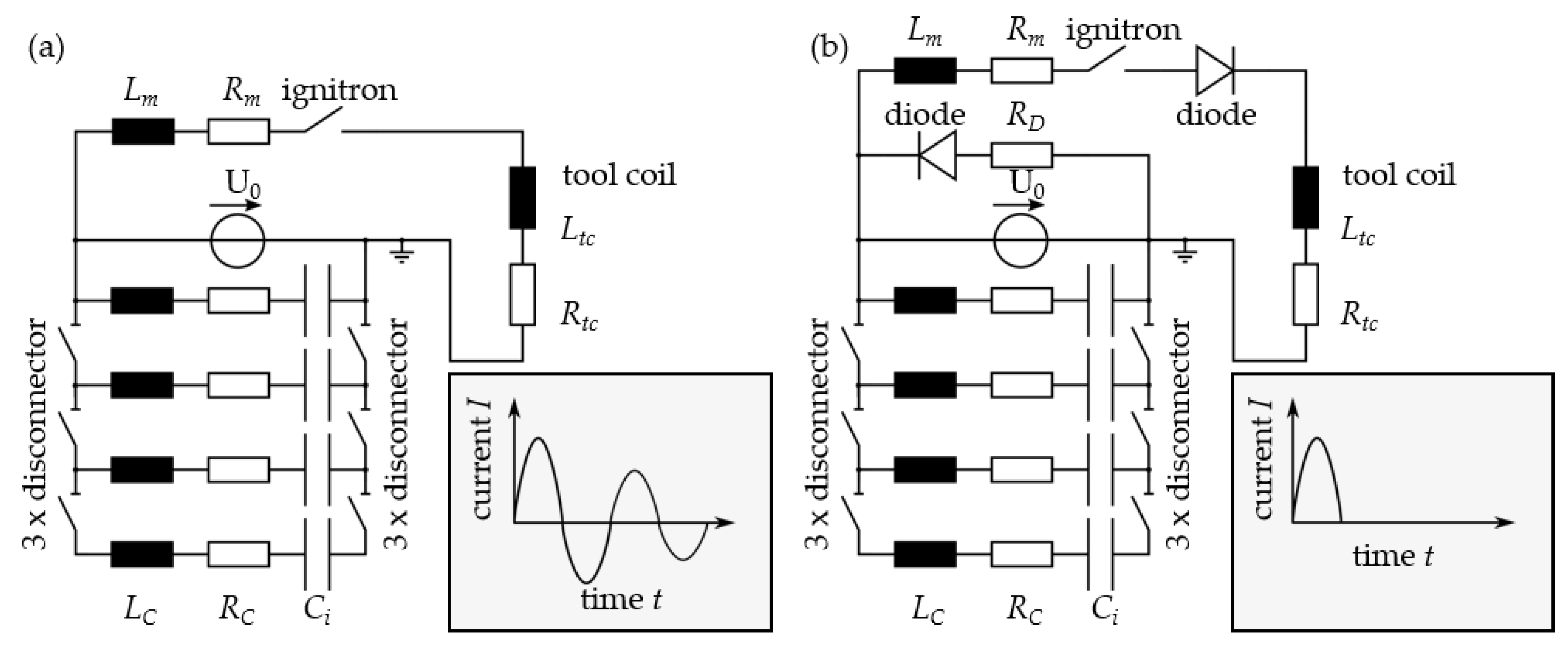

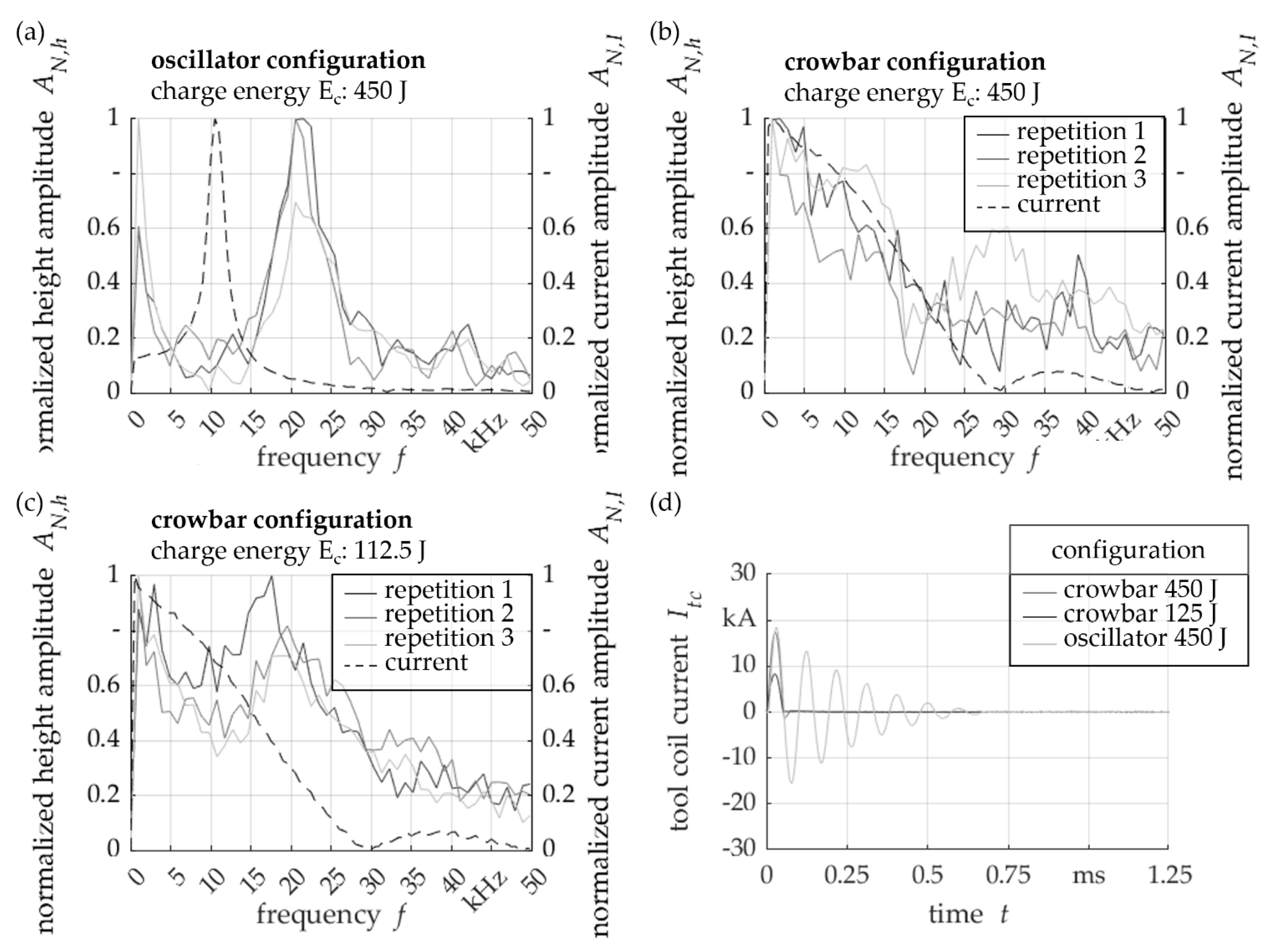
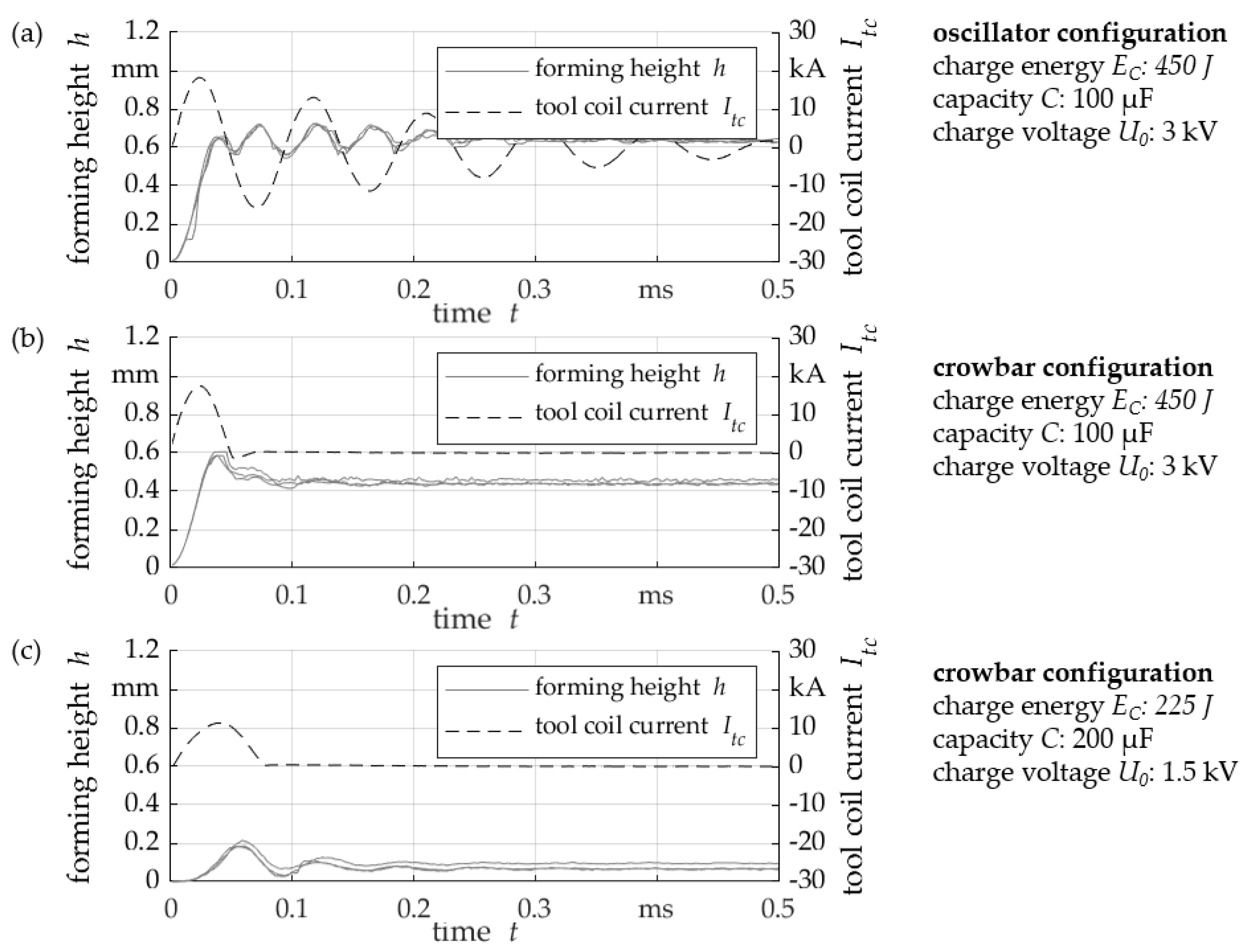
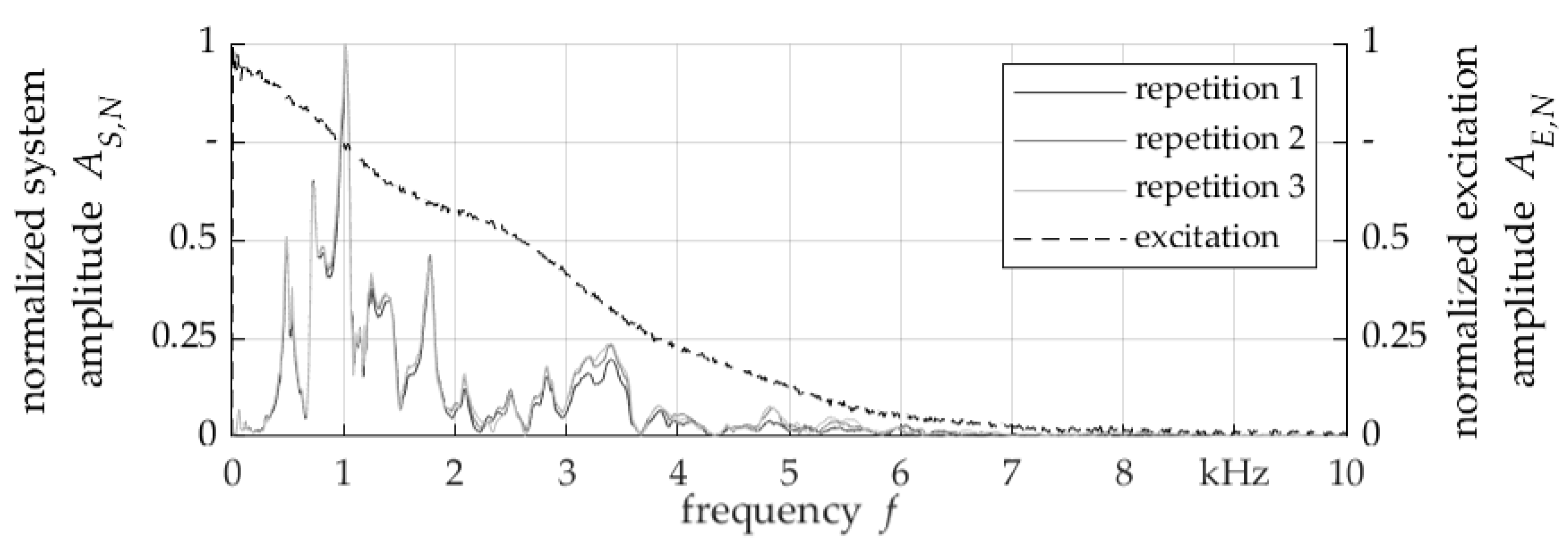
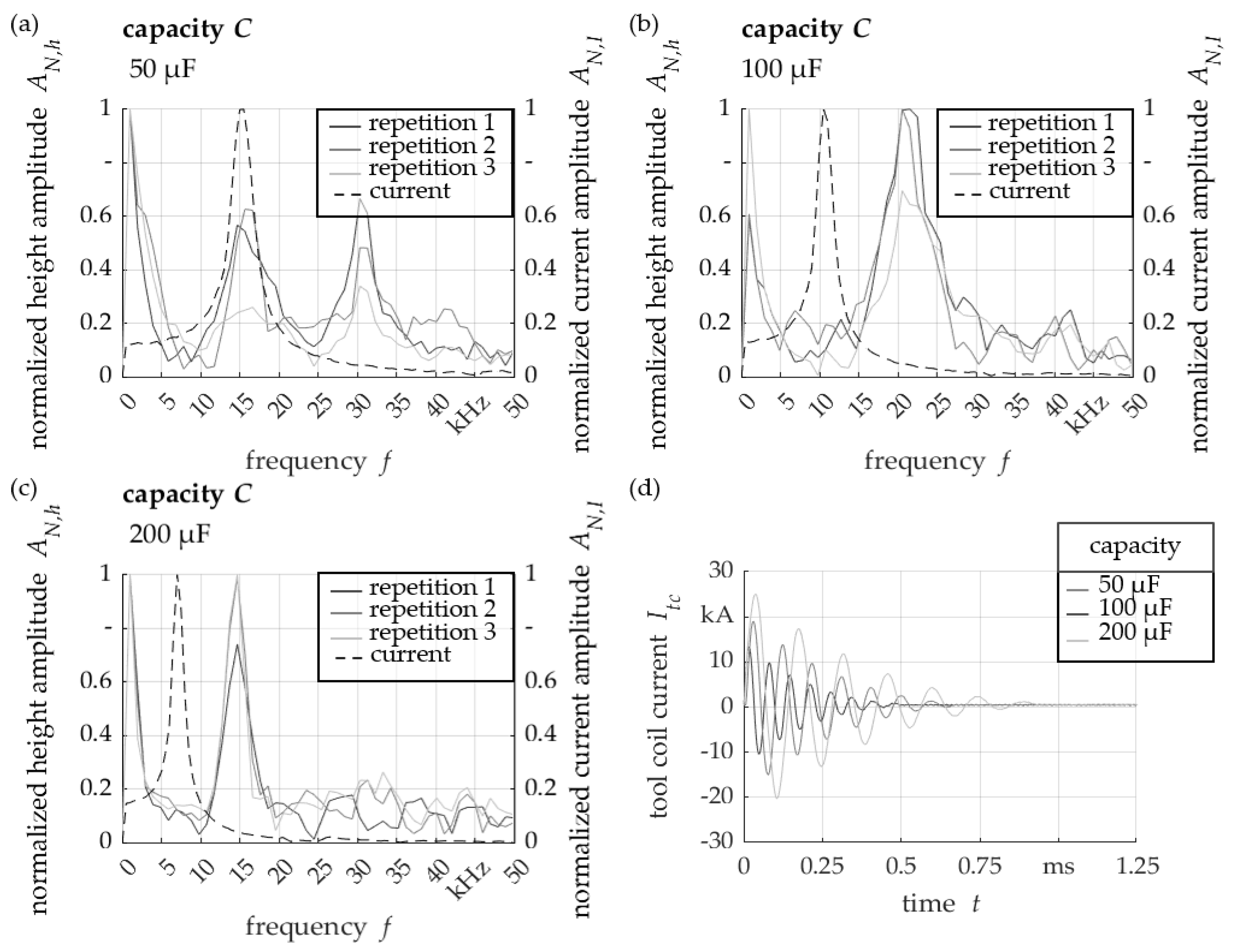
Publisher’s Note: MDPI stays neutral with regard to jurisdictional claims in published maps and institutional affiliations. |
© 2022 by the authors. Licensee MDPI, Basel, Switzerland. This article is an open access article distributed under the terms and conditions of the Creative Commons Attribution (CC BY) license (https://creativecommons.org/licenses/by/4.0/).
Share and Cite
Beckschwarte, B.; Langstädtler, L.; Schenck, C. Response of Thin Sheet Metal on the Excitation in Electromagnetic Forming. Eng. Proc. 2022, 26, 4. https://doi.org/10.3390/engproc2022026004
Beckschwarte B, Langstädtler L, Schenck C. Response of Thin Sheet Metal on the Excitation in Electromagnetic Forming. Engineering Proceedings. 2022; 26(1):4. https://doi.org/10.3390/engproc2022026004
Chicago/Turabian StyleBeckschwarte, Björn, Lasse Langstädtler, and Christian Schenck. 2022. "Response of Thin Sheet Metal on the Excitation in Electromagnetic Forming" Engineering Proceedings 26, no. 1: 4. https://doi.org/10.3390/engproc2022026004





